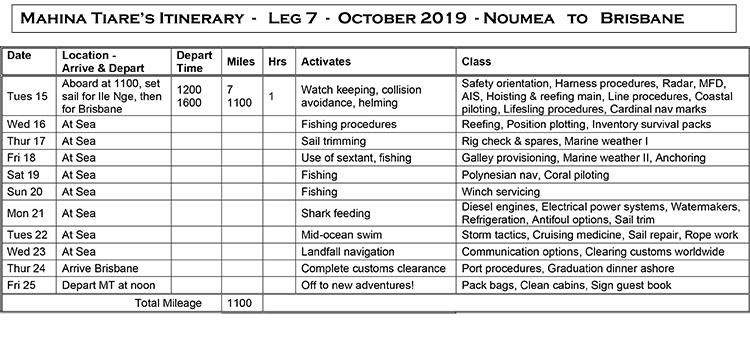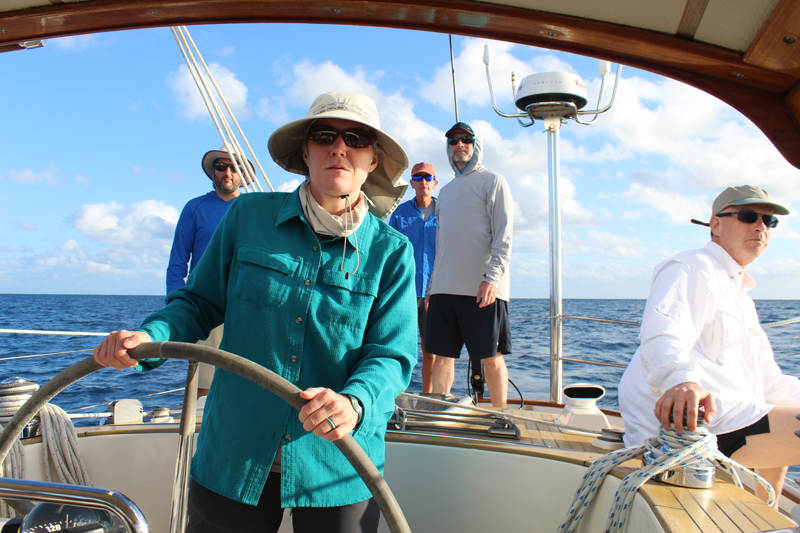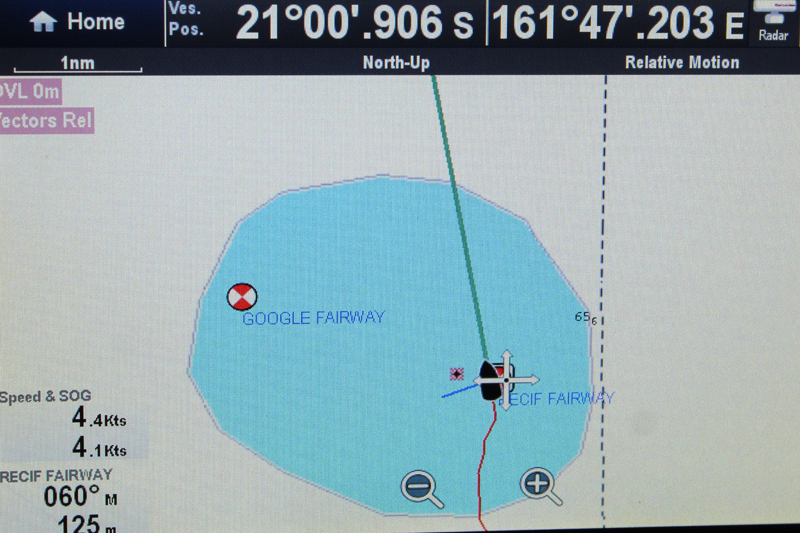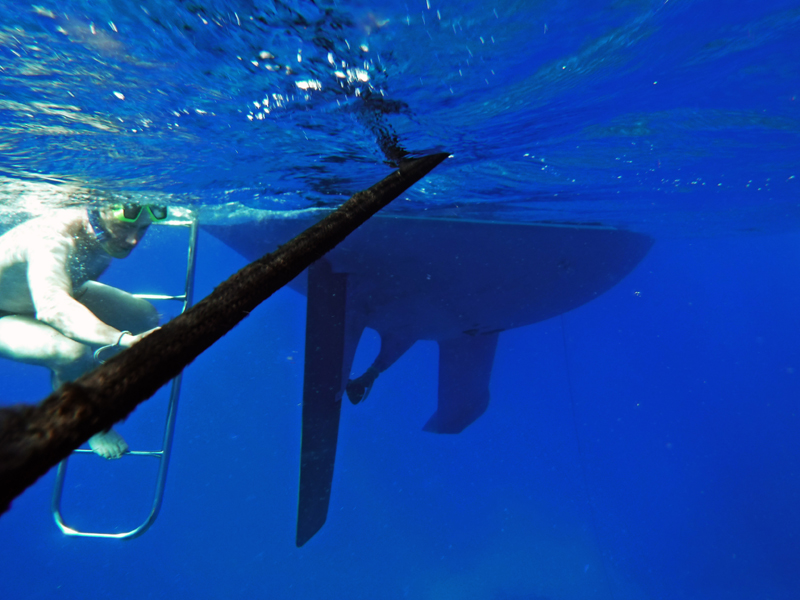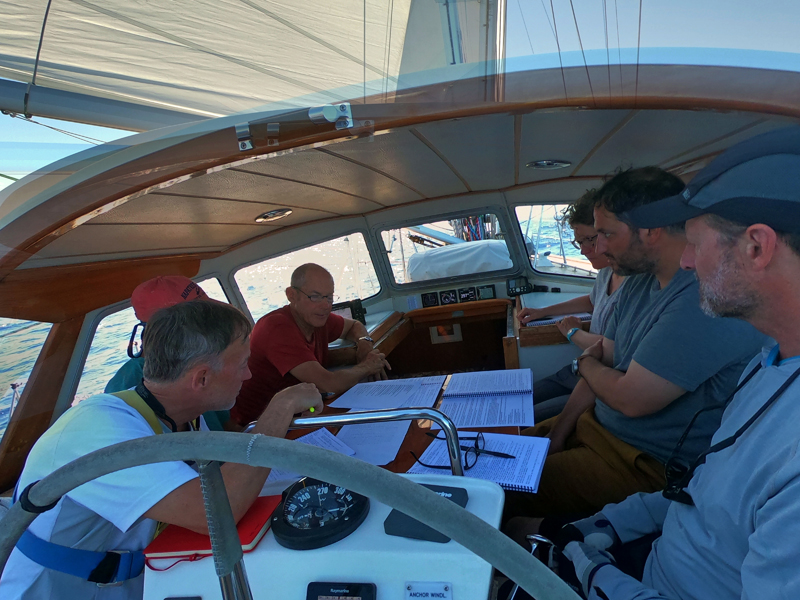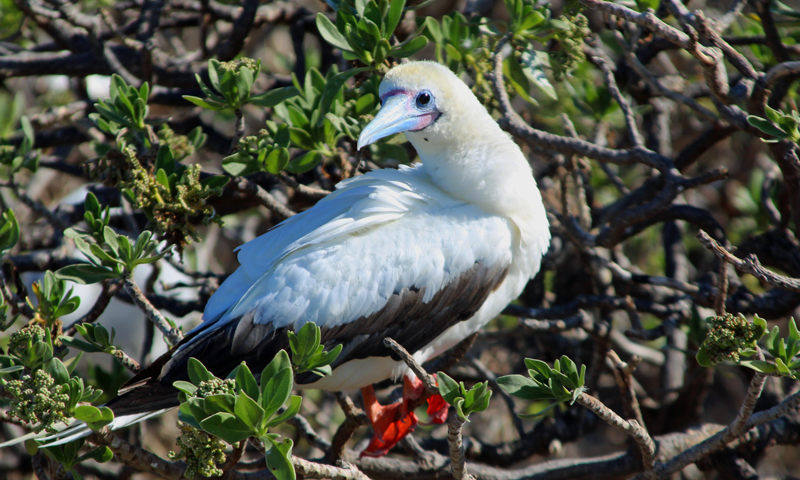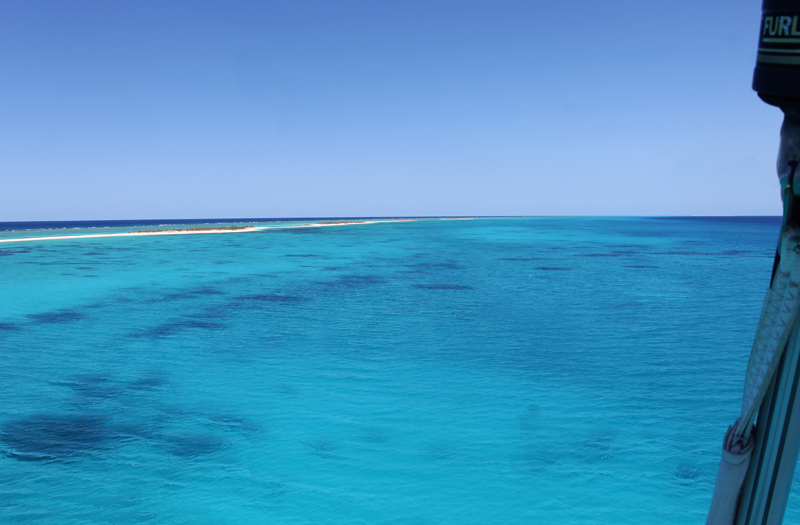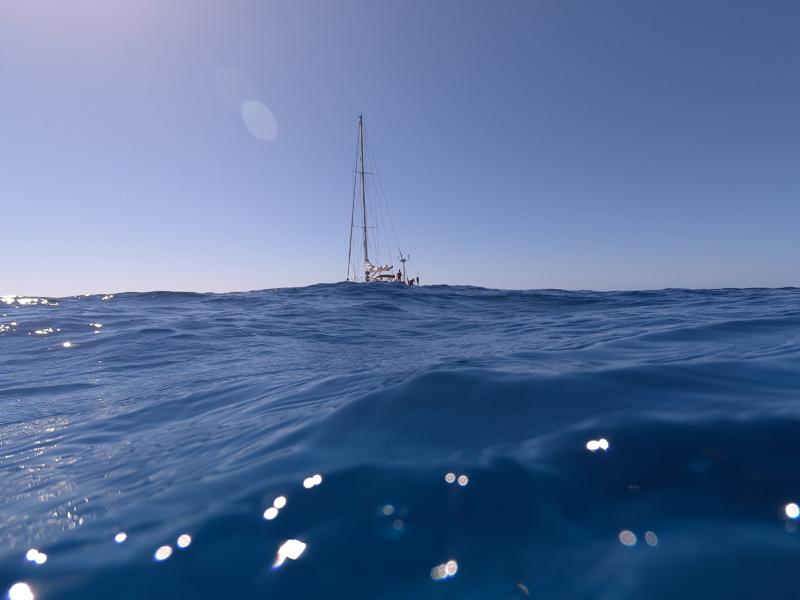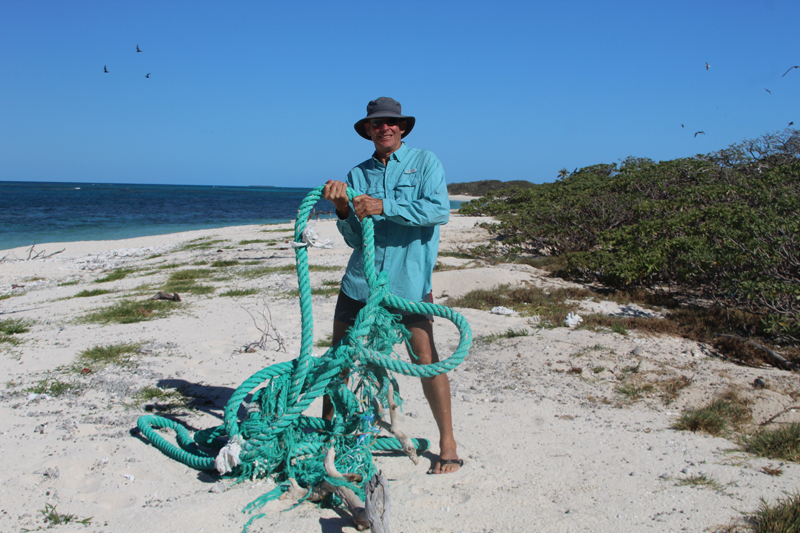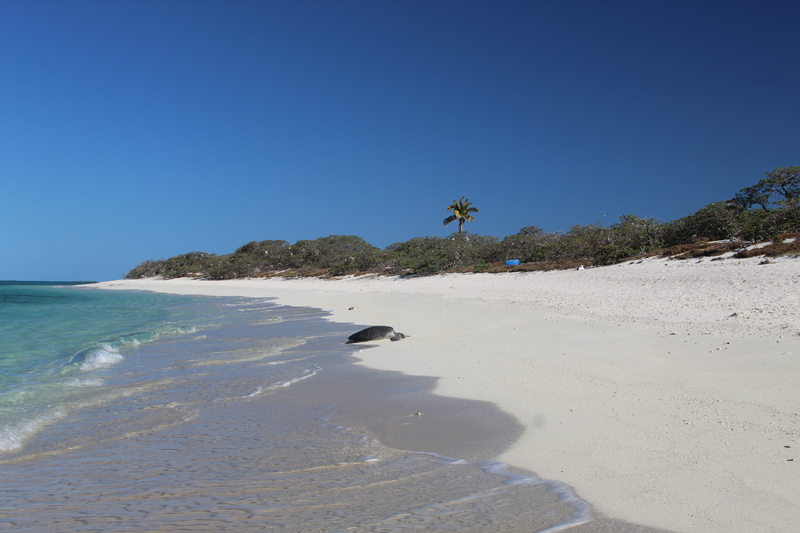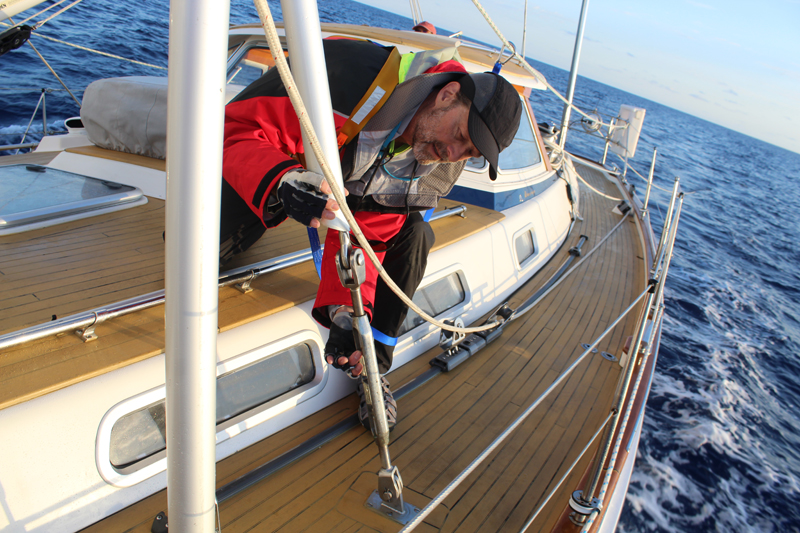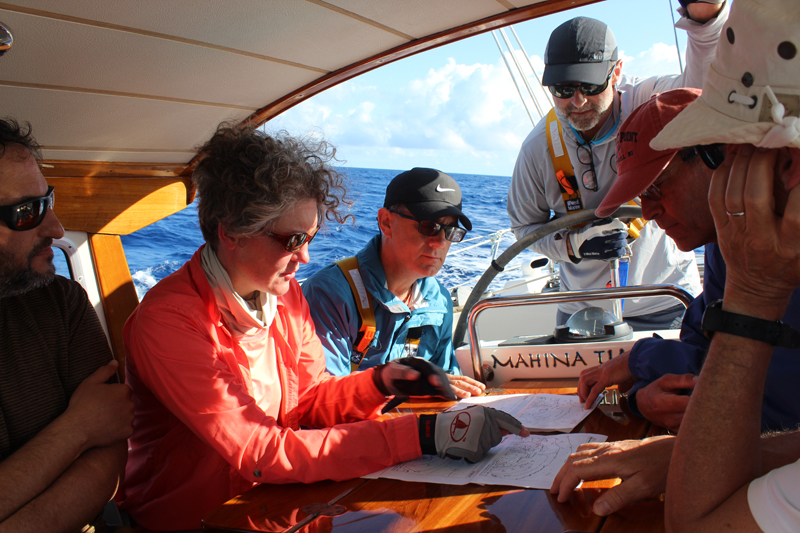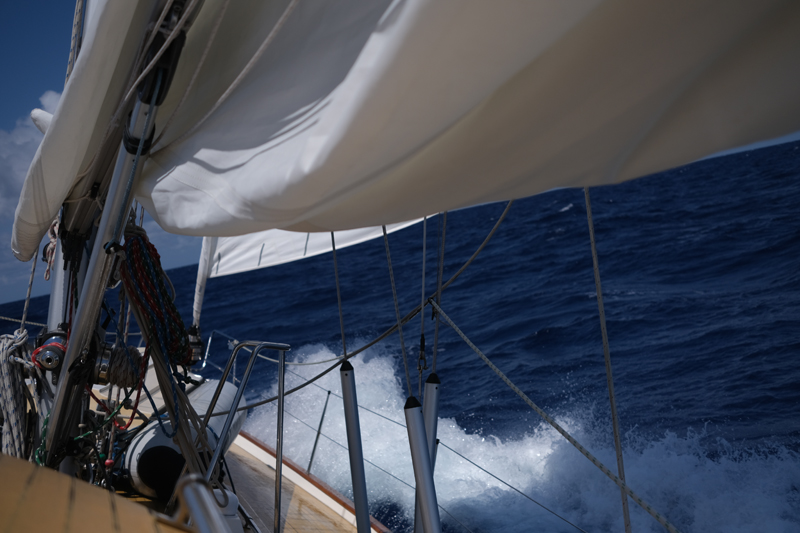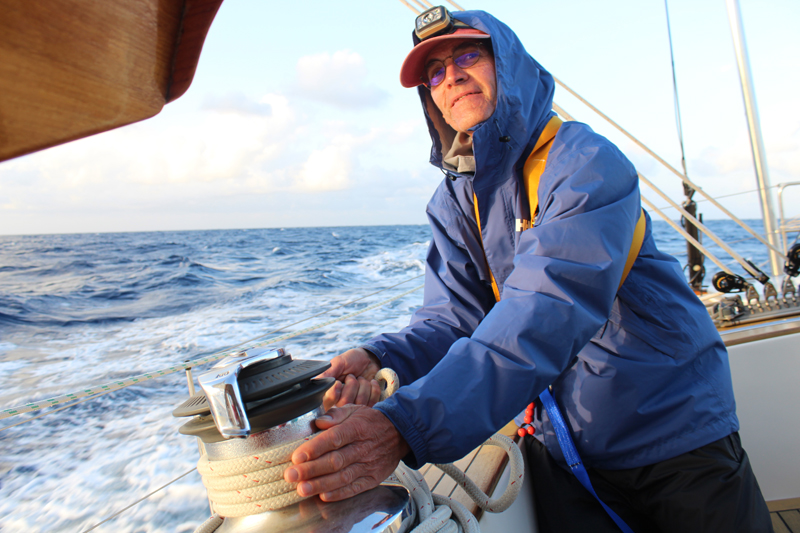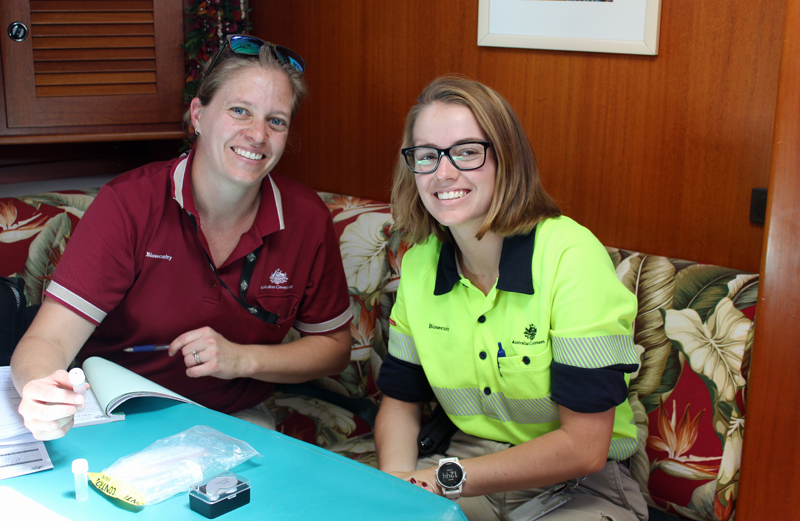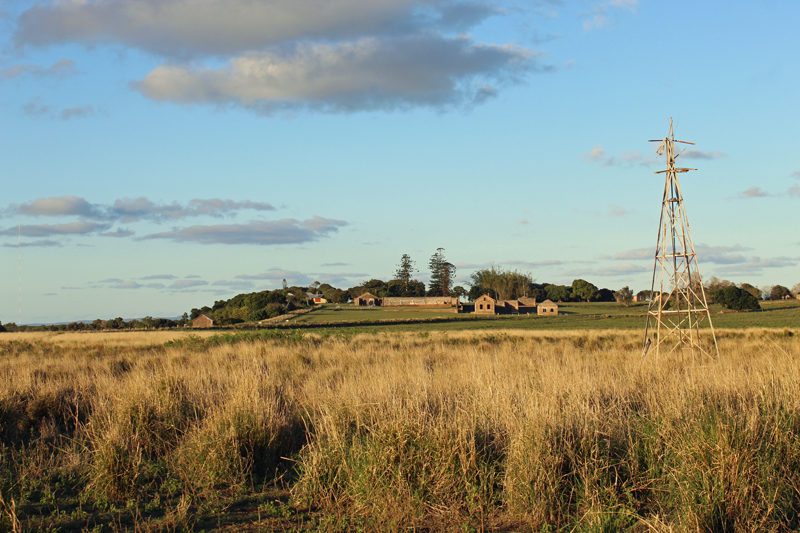October 22, 2019, 2019, 0915 hrs, 25.33 S, 155.06 E, Log: 228,901 miles
Baro: 1020.6, Cabin Temp: 758 F, Cockpit: 82F, Sea Water: 83.3 F
Close reaching at 7 kts in 15 kt SE winds with flat seas and glorious blue skies
MAGICAL UNINHABITED REEFS AND ISLANDS PLUS FAST SAILING!
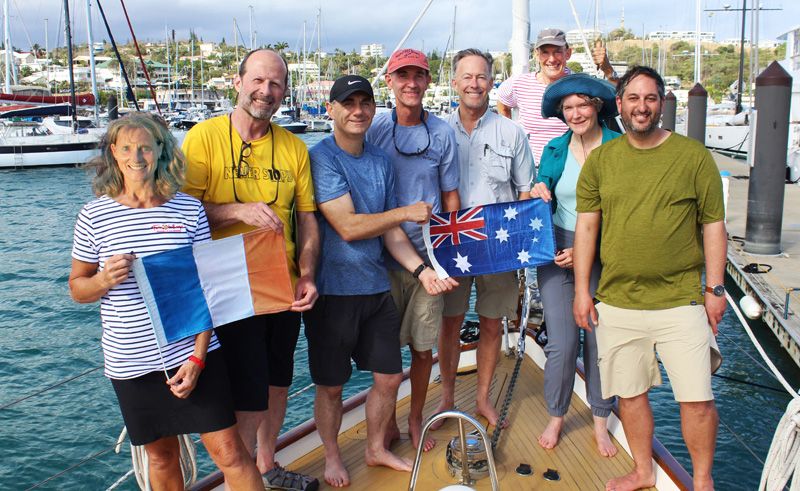
BONZER! We’re Amanda, Scott, Nigel, Tom, John I, John N, Rachel & Nojan and we’re off to Oz
What a grand adventure Leg 7 has been so far!
It all started with a large ridge of high pressure coming across from Australia, setting up the perfect weather window for anyone wanting to sail from Noumea to Australia. We’d collected passports Monday afternoon during safety orientation at our Port du Sud Marina location so that I could be on the doorstep of the immigration office across town, awaiting their 0800 opening. There was only one couple in the waiting room when I entered to hand the forms I’d earlier completed, but when I exited the inner office, the waiting room was jammed with 30+ cruisers complete with kids, backpacks for final grocery runs and ship’s papers. The three offices required for outbound clearance (immigration, customs and port captain) are located several miles from the marinas and spread out around the commercial port. I wore running clothes and shoes which allowed me to efficiently make their circuit plus stop by the market to get a couple hands of super green bananas (that still look like they’ll never ripen) to arrive back at the marina in under 2.5 hours.
|
|
Our crew were on the dock early (at our request) looking extremely energetic and focused. We slipped the dock lines and were smartly underway for tiny Ile Nge, inside Passe Dumbea, eagerly anticipating a swim with everyone pitching in for a final polish of MT’s Micron 66 antifoul. For our Australian Bio Security arrival, it’s extremely important that the bottom and all apertures be free of any barnacles or growth
After MOB, lunch, bottom scrubbing and the crew unpacking their kit into lockers we were soon underway and clear of Dumbea Pass on a course heading NW. Relatively excellent broad reaching conditions prevailed although we occasionally chose to motor when the winds went light.
Between New Caledonia and Australia there are many scattered and extensive reef systems. We selected a course that took us between the southern tip of Lansdowne Bank and an unnamed reef 15 miles to the south. It also took us just south of Fairway Reef, which some charts show as drying, but I’d forgotten to bring our copy of the Admiralty Sailing Directions for this part of the Pacific. I emailed our circumnavigator-friend Skip Sims in Hawaii, and he Googled and forwarded the following Google entry:
|
|
“The southeastern end of Lansdowne Bank is marked by Fairway Reef, thus named from its lying in the fairway between Australia and New Caledonia, midway between the Bellona Reefs (south of the Chesterfield Islands) and New Caledonia.
Fairway Reef is 3.2 kilometers (2.0 mi) long, about 4 to 5 fathoms (7.3 to 9.1 meters) deep, of coral bottom, and located at 21°00’15″S 161°45’09″E.
According to some sources, Fairway Reef dries at low tide.”
As this totally got my interest we altered course slightly, and sure enough, substantial breakers were visible three miles out. As we go closer, several of our gang spotted pink coral reef sticking above the breakers. Brilliant! I was now in search of an anchorage and explored the western lee of the reef choosing to anchor in sand and coral at 28 59.580 S, 161 46.615 E. Scott had volunteered to check for a clear spot for the anchor, but although there was extremely good visibility he discovered very few sandy spots. A 1.3 to 1.9 knots of current was a surprise and he suggested we tow a line behind MT if we all went swimming.
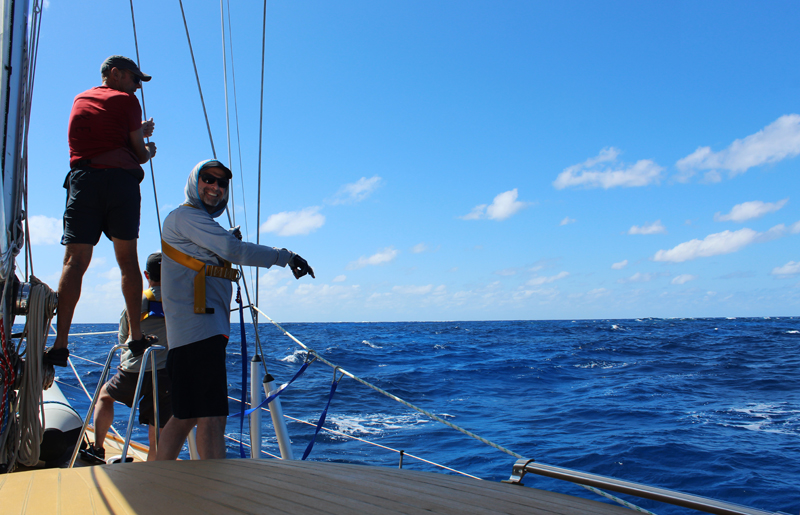
|
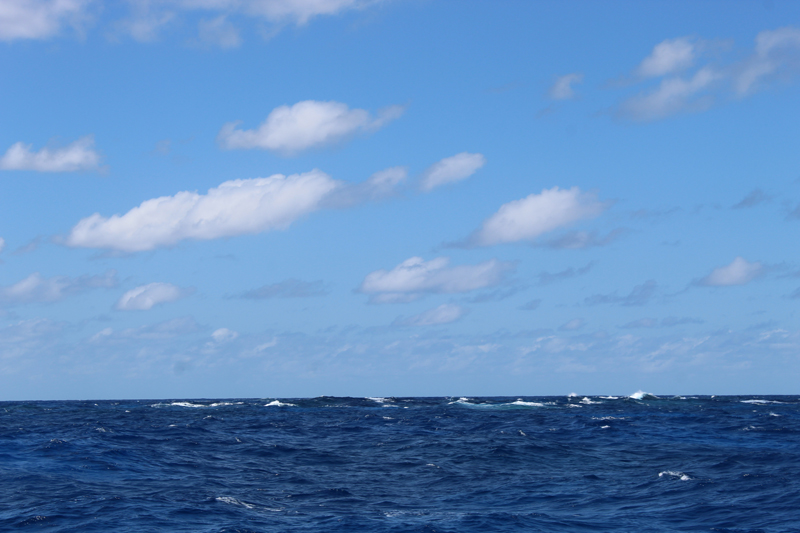
|
|
|
|
|
|
We decided to take our chances in anchoring amongst the coral heads and were soon in the water marveling at the crystal-clear views of colorful coral and large fish. Most impressive of all was the time to gaze around at the blue skies and seas, brilliantly white crashing breakers and the numerous seabirds soaring around.
When anchoring in offshore reefs like Fairway, it’s rare to find sand, so we put down only enough chain to barely hook a coral head, then when leaving slowly motor forward until the anchor drops free.
|
|
Our next stop was Chesterfield Reef, a huge mostly-submerged coral reef 190 miles to the NW which earlier expedition members Mark and Marie Claude have said was the highlight of their entire two-year cruise. Changing course after we rounded Lansdowne Bank put us on an excellent broad reach which we carried through the entrance and nearly to the Three Islets anchorage shown on French chart #5978 that Jim & Katie Thomsen (www.tenayatravels.com) had recommended.
Chesterfield Islands were named after the American whaling ship captained by Matthew Alt in the 1790’s. The islets have been scraped clear of guano several times and the lagoon has served as an off-season base for whaling ships. Wikipedia has an extensive list of ships that have been wrecked on the reefs.
We chatted briefly with an English catamaran of divers anchored off the windward islets before settling an anchorage closer to the beaches that had a smooth sandy bottom. We now had three options: go snorkeling, go aloft for rig inspection or head ashore – Once Amanda spotted two turtles resting in the tide line on the beach going ashore won hands-down!
Someone read that these turtles come ashore during the hours of darkness. They proceed up the beach to above the high tide line then dig huge holes in the sand before laying eggs. It’s then a tiring journey back to the ocean before morning only to return consecutive nights to lay more eggs. As we walked the length of several of the connected islets we passed dozens of turtles tracks and excavated holes.
On higher ground low scrub bushes and trees housed thousands and thousands of nesting seabirds, while a few were content sitting on eggs laid on the sand. Interestingly, the birds were not at all aggressive as we’ve experienced on several other isolated islets. They squawked and squawked as we quietly and slowly walked by, but never dive bombed us.
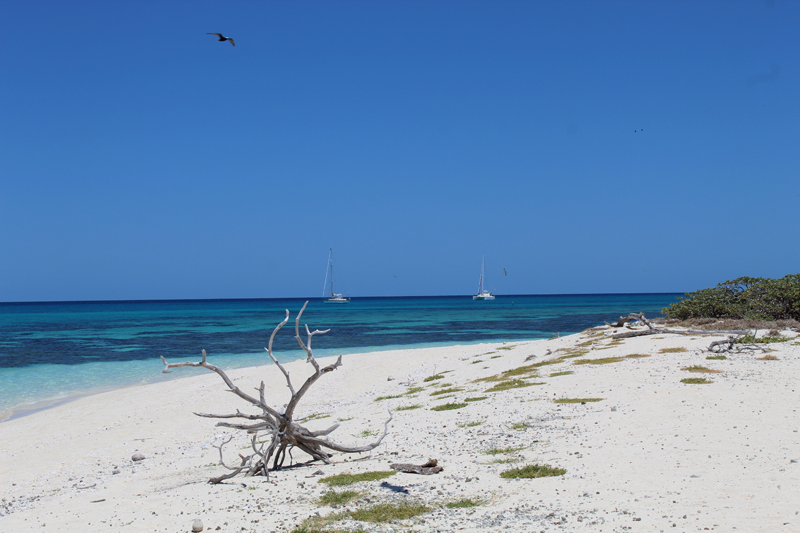
|
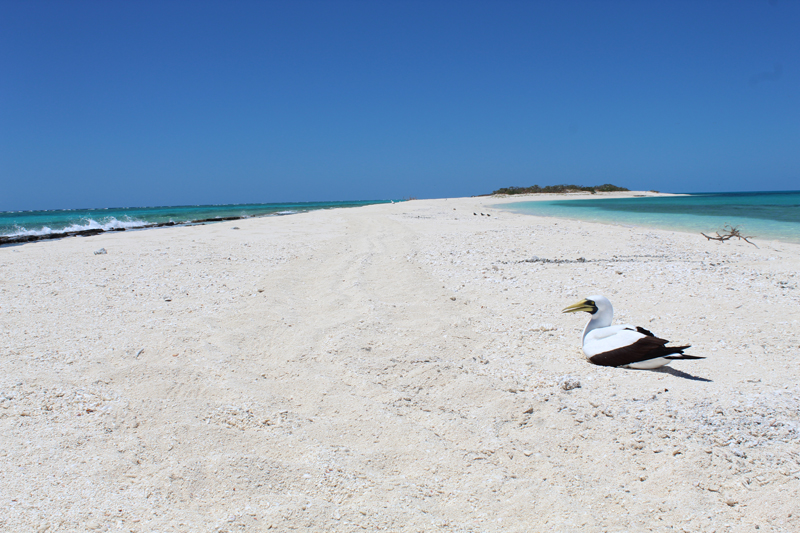
|

|
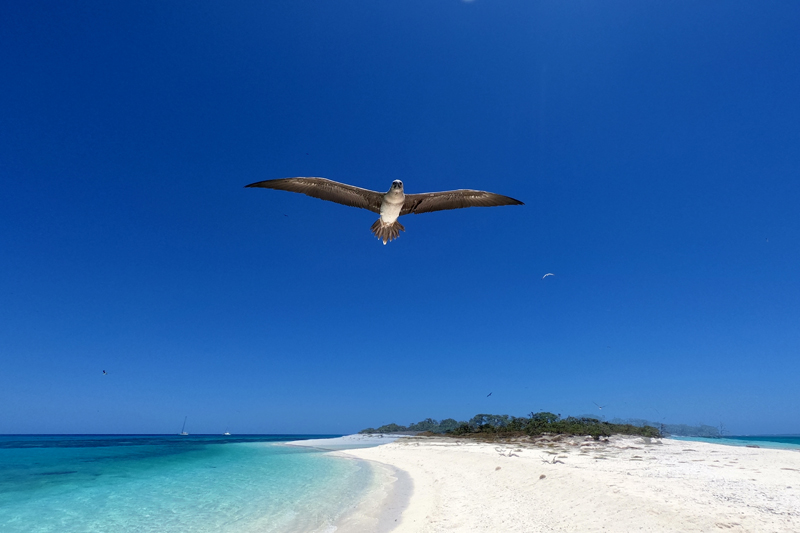
|
|
|
|
|
|
After a couple hours of exploring, we headed back to MT. This is where Amanda demonstrated going aloft for rig inspection before we hoisted anchor.
We then set off seven miles across the lagoon to Long Island, the largest of the Chesterfield Islands at 1600 meters long by 100 meters wide and 9 meters tall at the highest point, located to the south of an unnamed broad pass.
We all enjoyed a swim to view very healthy coral, a couple uninterested sharks and some huge parrot fish upon anchoring off Long Island.
|
|
|
Tom was the only taker on our offer to explore ashore and we watched several more turtles relax in the tidal waves and thousands more seabirds and a long, flat clearing that looked as if it could have been a runway at an earlier time.
|
|
|
Our goal was to have the anchor up by 1700 to have plenty of visibility while exiting the pass. We had an easy departure and an hour later all witnessed the green flash following a brilliant setting sun. The next couple days brought light air and calm seas, great for teaching, but only occasionally enough wind for sailing as we headed S on the 570-mile passage to Brisbane.
|
|
|
|
|
Sunday afternoon we rolled up the genoa and stopped in 3 kts of wind to do a final wipe-down of the bottom. It was Nigel’s birthday so we celebrated with a chili chicken dinner and sing along.
Nigel, 57, originally from England
I am an engineer living in Upstate NY working on silicon chips. The dream is to cruise with my wife Karen and daughter Leah when I retire. We’ve always loved to travel, but two weeks was always too short to really see the countries and experience the cultures of the places we visited. Learning to sail over the past two years and then getting our own boat will give us the time to truly appreciate each country and places well off the beaten path. Experiencing places like Chesterfield Reefs is one reason I’m learning to sail.
John, 64 from the SF Bay area
I’ve loved sailing since first learning on Long Island Sound at age 13. My family and I live in the Bay Area, sailing at OCSC in Berkeley and I work in Silicon Valley. We’re planning to acquire a cruising boat in Florida in 18-24 months for seasonal Caribbean cruising, spending hurricane seasons in our MA cottage, enjoying retirement.
Tom, 60 from Connecticut
I am blessed to be able to sail with my wife Patty and my 87 yr old Dad on our Seaward 32RK out of Old Saybrook, CT. Most of my sailing is daysailing in Long Island Sound with some extended trips to Rhode Island and NY. I have chartered in the BVI and Bahamas and future plans include some extended chartering and coastal cruising along the New England coastline…and who knows where beyond.
Scott, 60 from the greater Portland, Oregon area
I’ve sailed since college – dinghies, Hobies, sailboards and bareboat charters. For a number of years, I’ve dreamed of expanding my horizons, and this expedition was a key part of confirming those decisions, and I’m excited to know I can! I also have begun to learn how beautiful the ocean is, in all directions!
Rachel, 44 of Seattle
I started sailing soon after moving to Seattle in the early 2000’s and even crewed on Nojan’s J-24 for a few years. We wanted to cruise in retirement and decided to start looking for a boat after watching Robert Redfords’s “All is Lost”. (Rachel took heart in thinking she knew more and could perhaps do better than Redford) A year later we attended Amanda & John’s Offshore Cruising Seminar and decided life is short and we’d better plan a mid-career cruising break in 2020. When not preparing for the big cruise, I enjoy cooking, craft beer and developing my career as a casualty actuary.
Nojan, 47 of Seattle
Exploring the Coral Sea aboard MT has been a tremendous adventure. As we navigated out of New Caledonia and sunset descended we slipped into our first offshore passage. The following morning our navigator of the day found an island on the chart and we adjusted course and sails to go find it. Unbelievably it was a seamount that just broke the surface so we anchored and went for a swim in the middle of the ocean. Unforgettable!
I stumbled into sailing in middle school and it was an instant infatuation. Over the years I learned to be a decent day sailor, then got into racing and then coastal and offshore cruising. I’m yet to find the end to the learning and physical tests that sailing provides. Next year I’m putting J-24 racing on hold to cruise our HR 36 from Seattle to Mexico and beyond. We love it.
For several days several weather sources predicted we would have SE winds gusting to 40 – 50 kts, the night before we’d reach Brisbane. Not wanting to be close-hauled in these conditions, we’d set a course directly south to preserve easting. Predictwind.com forecast of the arrival time and duration was excellent, and following dinner, Tom wondered out loud if it mightn’t be easier tucking the third reef in the main before dark. When several of our hearty crew mentioned they’d really love some heavy weather experience. I thought, “Be careful what you wish for!”.
Heavy conditions soon hit hard with a couple of drenching downpours and rouge waves which crashed aboard, partially flooding the cockpit and two dorades. By midnight, winds were still in the low 30’s and the seas were still crossed and confused, but we were able to ease sheets and head directly toward Brisbane, making the ride smoother.
|
|
|
By breakfast all reefs were shaken out, the genoa unfurled and MT was smokin’ along at 7kts, right on course for Brisbane! Our crew were delighted with the few hours of heavy weather conditions, saying it was just the right amount. Our seas moderated enough for me to be able to remove three engine room doors and conduct our engine room checkout and Amanda is currently conducting Sail repair class.
Earlier we were overflown by an F-15 fighter that also checked out two nearby container ships and we’re now wondering if that is in connection with our 96-hour pre-arrival notification that we sent a couple days ago.
October 26, 2019 0915 hrs, 27.27 S, 153.11 E, Log: 229,087 miles
Baro: 1020.6, Cabin Temp: 758 F, Cockpit: 78F, Sea Water: 86.0 F
Royal Queensland Yacht Squadron, berth K-42
Excellent sailing conditions plus the 1kt south-setting current had us trying to put on the brakes so we wouldn’t arrive before dawn at the NW Fairway buoy, the entrance to the 46-mile channel into Rivergate Marina’s quarantine dock. Very early Wednesday morning we passed several freighters and tankers then ran through quite an intense and closely-spaced line of 50-60’ coastal fishing boats of which only one was transmitting an AIS signature so we experienced some tense moments tracking them on radar and trying to figure out their intentions.
We’d spotted the large and very well-lit NW Fairway buoy on schedule and as we’re at the western edge of this time zone (and on Queensland time) first light occurs well before 0500. Our navigator had a busy morning ahead keeping us in the narrow, twisting channel while the on watch kept a traffic lookout.
Inland a few miles, we sighted the spectacular Glasshouse Mountains in the clear morning light which so fascinated Captain Cook that he and several of his shipmates left the Endeavour, hiking to, exploring and mapping these mountains. These mountains also intrique Amanda and I during our first Australian landfall in 2011. We’d rented a campervan in Brisbane with plans to explore further north but ended up so enchanted with this area that we spent a couple days camping and trail running there. The following year we decided to return and explore some more. I’d discovered www.glassonglasshouse.com.au: three self-contained architect-designed all-glass cottages, set in the midst of the mountains and surrounded by wildlife, and was hooked.
|
|
We’d arrived in the channels as the tide started to ebb and soon found a couple shortcuts allowing us to exactly make our 1000 hrs appointment at the Rivergate Marina quarantine berth. Not only had I emailed the required Pre-Arrival Notification info, I’d also emailed customs daily updated ETA information.
Minutes after we tied up, two Border Force officers pulled up to the gate. They were a bit surprised and very pleased to see that we had all of the paperwork completed (a big thanks to John Hemlaw of Go West Rally who gave us the forms in Fiji). After asking us the usual questions they interestingly handed me a reduced version of the same nav chart we’d been plotting on asking me to draw our approximate route since departing Noumea. Mishell, the lead officer, advised that we’d need to give Border Force a four-day notice of our proposed departure time, but since I know when our Leg 8 crew arrive, we set the date and time then – 10am Tuesday, November 8, and as soon as Mishell returned to her office she forwarded me the outbound customs forms
|
|
Bio Security arrived shortly after and promptly spent two hours searching for termites in EVERY nook and cranny. With bright flashlights they peered high and low including pulling out all the drawers. When, amongst my breakfast cereal bin, they found and captured a tiny live bug and swept up two dead ones the officers appeared almost jubilant. After dropping them into vials they advised the live bug was unidentifiable by them. It had shriveled up to a teensy size and they were no longer able to view a thorax at the abdomen section therefore it would be taken immediately to an entomologist. We advised them of our location and they stated we’d be alerted if the bug was “actionable”.
After Bio departed, we dropped our lines and headed down river, and down current to St. Helena, a small national park island that had been home to one of Queensland’s first prisons. We found a sheltered anchorage off the pier and were surprised the island was totally deserted – even the park ranger had departed. Some of the prison buildings have been restored, but one must be part of a tour to visit them. We were happy to explore the areas allowed without a guide and were amazed and delighted at hundreds of wallabies bounding in all directions.
|
|
|
We had not only a brilliant sunset during dinner, but also the city lights and a totally peaceful anchorage. Being a day ahead of schedule, one of our options had been to ask the marina if our berth was available, but we were all so glad we didn’t. Early Thursday morning four of us headed ashore for a run then swim and after breakfast we were underway, then in the sizable Royal Queensland Yacht Club marina. searching for berth K 42.
Once checked in, I led our final class – Dealing with Customs Worldwide before our crew set off to explore Manly, our favorite little seaside town in Australia. Our graduation dinner was at the Thai restaurant and this morning crew pitched in with Scott, Rachel and John washing tons of accumulated salt off before hoisting Amanda aloft to replace a nut on the new turnbuckle. Meanwhile Nojan and Nigel were troubleshooting (and solving!!!) a very occasional fault that had been causing our 24-volt alternator to stop charging. Nojan went so far as to call and explain the problem to Balmar’s hugely-helpful tech support staff and finally – thanks in part to the Balmar tech-support guy – a solution!
Basically our voltage regulator would completely stop working if it got too hot. Problem was solved by installing a new regulator which was in our spares locker and reprograming it for our Lifeline AGM batteries.
I also received more good news email from Bio Security: the bugs were “Non Actionable. I asked what they were and was told the following.
1. Saw toothed grain beetle (Oryzaephilus surinamensis)
2. Parasitoid Wasp (Cephalonomia tarsalis)
3. Dead Snout or Bark beetle (Curculionidae suspect Sitophilus sp.)
Amanda made it clear that the bugs were in my “area” – where I stow breakfast grains and cereals. Next year, I’m taking out all the bins out for a “spring” clean before we leave Noumea!
Then BINGO…Leg 7 was officially over and we were saying goodbyes on the dock, all a little sad, I think…we’d shared some great times and adventures!
Speaking of adventures, Amanda and I have been working flat out since noon, getting MT cleaned and prepped for Leg 8 so that we can again slip away to the Glass House Mountains.
With the recent news from a girlfriend of Amanda’s that COSTCO is opening in Auckland in 2020 we went online and discovered they are now in Australia. Bonzer!. Brisbane has two stores…I’m sooo excited as one is on our drive north…planning a stop on the way up for a reconnoiter then a second in few days on the way back in case we missed some goodies. Amanda’s hoping they have Vegemite by the case, and I’m praying they don’t!
